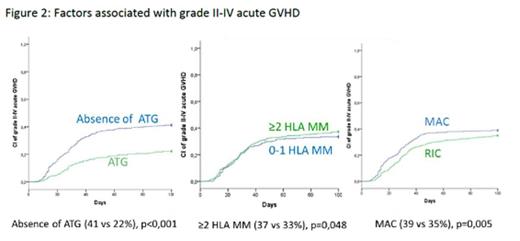Abstract
Double umbilical cord blood transplantation (dUCBT) has extended the applicability of UCBT for hematologic disorders especially to adult patients (pts) for whom the low cellular content of a single unit is a limiting factor. However the use of dUCBT has been, recently, associated with a higher incidence of acute graft-versus-host disease (aGVHD) when compared with single UCBT (sUCBT). Moreover, several retrospective and prospective studies have addressed risk factors for aGVHD with some conflicting results. Whether the number of total nucleated cells, HLA disparities, type of conditioning regimen or GVHD prophylaxis have an impact on aGVHD incidence in dUCBT is yet to be established in a larger series of patients. With this background, this report analyzed 921 adult recipients who underwent dUCBT for hematologic malignancies from 2005-2012 in EBMT centers.
Median age was 46 (range, 18-72) years (yrs) and 59% were males. Diagnosis was acute leukemia in 56%, MDS/CML in 19% and lymphoid malignancies in 25%; 22% of pts received at least one prior autologous HSCT. Reduced-intensity conditioning (RIC) was used in 68% of pts and the most common regimen for both myeloablative conditioning (MAC) and RIC was Cyclophosphamide-Fludarabine-TBI (TCF) (40% and 78%, respectively). ATG was used in 30% of pts. GVHD prophylaxis consisted of a MMF based regimen in 774 pts (84%); cyclosporine±steroids in 103 (11%) and MTX-based regimen in 44 (5%). HLA incompatibilities were classified using the cord blood unit bearing the highest degree of mismatch with the recipient: 1% were HLA matched 6/6, 25% were 5/6, 67% were 4/6, and 7% <4/6. Median TNC collected was 4.8x10e7/kg.
With a median follow-up of 26 months (range, 3-98) aGVHD was absent in 418 patients (46%), 169 pts developed grade I (18%), 194 grade II (21%), 103 grade III (11%) and 37 grade IV (4%). One-hundred day cumulative incidence (CI) of aGVHD grade II-IV was 36%±2% and III-IV 15%±2%, with a median time of onset of 28 days (range, 4-97). Of those pts with grade II-IV aGVHD, 82% had skin, 66% gastro-intestinal tract (GIT) and 25% liver involvement. The most common organ involvement in pts with grade III-IV aGVHD was GIT (89%) followed by skin (71%) and liver (39%). Treatment of grade II-IV aGVHD was steroid alone in 91% of pts. For pts with grade III-IV aGVHD steroid was used alone in 77% of pts, 11% received steroid+monoclonal antibodies, 3% steroid+MTX and 9% other treatments (figure 1). At day 60, CI of neutrophil engraftment was 84%. Out of the 712 pts at risk, 218 developed chronic GVHD (cGVHD) with a CI at 2 yrs of 25%±5%. Of these, 102 pts (47%) had previous aGVHD grade II-IV and 116 (53%) had de novo cGVHD. CI of early NRM (at day 100) was 13%. At 2 yrs, the probability of PFS was 37%, NRM 35% and relapse 28%.
In multivariate analysis, the following factors were associated with an increased incidence of grade II-IV GVHD: use of MAC (HR: 1.45 (1.12-1.91), p=0.005), absence of ATG (HR: 2.39 (1.78-3.30), p<0.001) and ≥2 HLA mismatches (HR: 1.35 (1.01-1.81), p=0.048) – figure 2; whereas advanced stage disease at transplantation (HR: 1.76 (1.10-2.80), p=0.02) and absence of ATG (HR: 2.54 (1.56-4.13), p<0.001) were associated with increased incidence of aGVHD grade III-IV. Presence of 2 or higher HLA mismatches was associated with increased incidence of cGVHD (HR: 1.5 (1.1-2.05), p=0.01). In a time dependent model the presence of grade II-IV aGVHD was associated with lower relapse risk (HR: 0.71 (0.54-0.94), p=0.02), higher NRM (HR: 1.4 (1.1-1.76), p=0.005) and increased incidence of cGVHD (HR: 1.92 (1.59-2.63), p<0.001).
Despite previous analysis showing increased incidence of acute and chronic GVHD after dUCBT, our study demonstrated that the GVHD incidence remains relatively low in dUCBT setting when compared to published data on HLA matched adult donor. In pts developing grade II-IV aGVHD, skin was the most common organ affected, followed by GIT and liver. Steroid alone was the backbone treatment of aGVHD and the association of steroid and other therapies (mainly monoclonal antibodies) was mostly seen in pts affected by grade III-IV aGVHD. Acute GVHD grade II-IV seems to be influenced by the intensity of the conditioning regimen, the use of ATG, and HLA compatibility; therefore prospective trials evaluating the role of these factors in dUCBT should be addressed.
No relevant conflicts of interest to declare.
Author notes
Asterisk with author names denotes non-ASH members.



This feature is available to Subscribers Only
Sign In or Create an Account Close Modal